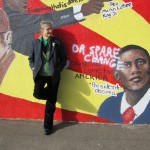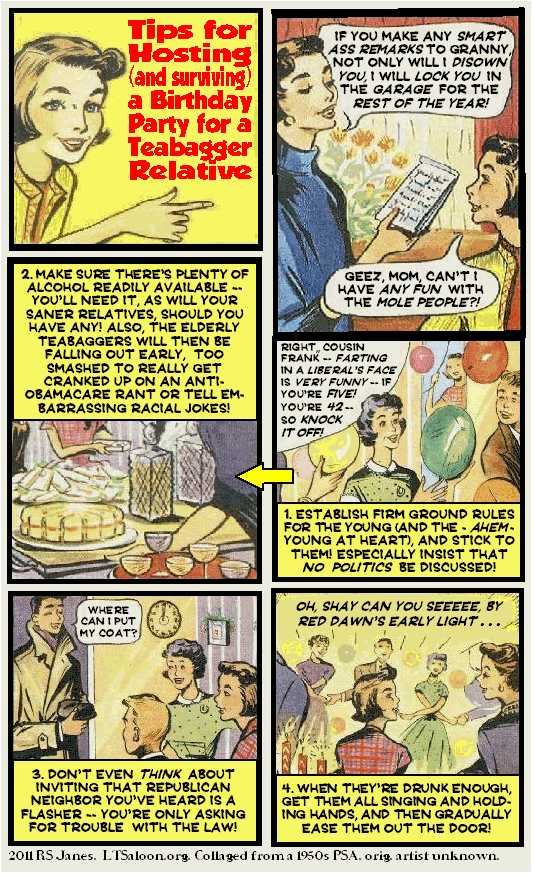
February 3, 2011
February 2, 2011
Non-violent protests in Egypt: BRING IN THE WOMEN!
Hosni Mubarak is once again acting like the slimeball that he truly is — shamelessly employing his mafia thugs against peaceful protesters. Even as we speak, that creep is using paid thugs on camels and horses to cut a bloody swath through the non-violent demonstrators in Tahrir Square. Mubarak is still a monster. Nothing has changed.
And faced with all this new slimy outrageousness, what should Egypt’s non-violent protesters do now? Should they fight back? Absolutely not. Would Gandhi have done that? No way! He would have done something else — but what?
These protesters need to bring in their secret weapon, their Second Line Club, their last-ditch Hail Mary play. They should BRING IN THE WOMEN!
If Mubarak’s scum-patrol also attacks non-violent women who are standing up for Democracy (they’ve already attacked poor sweet Anderson Cooper), then Mubarak will be truly exposed (once again) for the pond-scum lowlife that he really is.
Women hold up half the sky on this planet — and also in Egypt. And I’m sure that if Mubarak’s mother were around to see what her misbehaving son is up to right now, she would give him a rigorous timeout and send him off to bed without any supper. And then she too would go out and join the non-violent protesters in Tahrir Square. Go mom!
PS: The women of Egypt — and the world too! — all need to unite against violence. Lighten up, guys. As soon as the guns come out, all the fun goes away.

February 1, 2011
Cairo & Katrina: A tale of two cities
I just read an article by Chris Hedges, wherein he stated that the revolt in Egypt is a Muslim thing. I usually agree with Prof. Hedges on most things, but in this instance he is wrong. Sorry Chris, but the revolt in Egypt isn’t a Muslim issue. It’s a Gandhi thing. Yay!
Here’s what I’m thinking: In the last several decades the Arab world has witnessed how ineffectual its violent pre-1967 attacks on Israel were, how Arafat’s Fatah violence failed to stop the spread of Israel’s brutal occupation, how violent insurgency against the American occupation of Iraq turned out to be futile, how the insurgency in Afghanistan is such a bloody mess, and how Pakistan is getting chewed up and spit out by violence. Under these sorry circumstances, the Arab world’s violent protest against their Western occupation seems to have lost some of its charm.
And then along came a hopeful example — set by the obscure little farming villages of Budrus and Bil’lin, on Palestine’s West Bank. In these two small and inconsequential villages, poor and simple farmers were being tear-gassed, shot at, imprisoned, tortured and surrounded by a very ugly apartheid Wall. Their olive orchards were being stolen, their children were being injured and killed. “What can we do? What can we do?” the village elders asked themselves.
How could these simple villagers possibly fight back against the sixth-largest standing army in the world? They couldn’t. So instead of using stones and pitchforks against the intruders, they simply organized some non-violent protests against the injustice of having their lands and homes stolen by a gang of outlaws and rustlers driving REALLY big tanks.
And the next thing you know, the villagers’ plans began working! Whether Israel got tired of being shamed by the sudden negative publicity that it began to receive all over Europe or just finally got tired of tired of shooting at peacefully-protesting women and children, Israel’s occupying armies and tanks and fighter jets and what-have-you actually began backing off!
And the Arab world began taking note of this — and started to read up on its Yasu, Gandhi and Martin Luther King.
Always remember that there are many more people under occupation in the Middle East than there are people doing the occupying. And if you are gonna be nasty about how you occupy countries, then you’re gonna build up resentment. “Oh, that’s okay. Let them resent us all they want. No problem. We have guns and tanks and knives and torture kits and prisons. We’ll keep them in line.” However, that attitude only goes so far when you are stealing a whole BUNCH of people’s land, water and/or oil.
“Okay, Jane, you’ve made your point. I can see how non-violence might actually work in the Middle East. But how does Katrina fit into all this?” Well. I was just noticing that there is a similarity between what is happening in Cairo today and what happened in New Orleans back in 2005 — with regard to the tone and style of American evening news reports concerning both incidents.
When New Orleans first got hit by its disastrous hurricane and flood, American newspapers went out of their way to report NOLA residents as being uncivilized barbarians. Major news media jumped all over themselves talking about all the violent looting and all kinds of horrors going on there. But after the dust had settled a bit, it became clear that most of the victims of Katrina had been peaceful and helpful — and even that many of the shootings and atrocities there had been actually perpetrated by the police.
According to the New York Times, “The narrative of those early, chaotic days — built largely on rumors and half-baked anecdotes — quickly hardened into a kind of ugly consensus: poor blacks and looters were murdering innocents and terrorizing whoever crossed their path in the dark, unprotected city. ‘As you look back on it, at the time it was being reported, it looked like the city was under siege,’ said Russel L. Honoré, the retired Army lieutenant general who led military relief efforts after the storm. Today, a clearer picture is emerging, and it is an equally ugly one, including white vigilante violence, police killings, official cover-ups and a suffering population far more brutalized than many were willing to believe. Several police officers and a white civilian accused of racially motivated violence have recently been indicted in various cases, and more incidents are coming to light as the Justice Department has started several investigations into civil rights violations after the storm.” http://www.nytimes.com/2010/08/27/us/27racial.html?_r=1
So my point here is that this kind of reporting based on ugly rumors and “half-baked anecdotes” is apparently happening with regard to Cairo as well as NOLA. Also according to the New York Times, “Looters from Cairo’s vast shantytowns attacked gleaming suburban shopping malls, wild rumors swirled of gunfights at the bridges and gates to the most expensive neighborhoods and some of their residents turned wistful about Mr. Mubarak and his authoritarian rule.”
However, eye-witness reports surfacing on the internet reveal a completely different story. “Most of the thug types who are doing most of the attacks are prisoners who have been released by that bastard Mubarak in return for their services to beat up civilians…. You know about the secret service police guys who were citizen arrested at the museum and handed over to the army? You know so many of the protesters held hands, man, and formed like this long cordon around the museum so that these police pretending to be looters could not go in and destroy our history…and then they found out that these secret police guys were already inside and even damaged some Mummies. I mean people were so furious and they just handed them to the army.” http://mondoweiss.net/2011/01/muslims-christians-we-are-all-egyptians-scenes-from-a-revolution-as-told-by-one-eyewitness.html
And as the true story comes out, I think we will find that most Cairenes have been non-violent and peaceful — and that they are simply peacefully protesting their lot, after having endured over 30 years of indignity and bondage at the hands of a brutal dictatorship financed by the United States.
The spirit of Gandhi truly has arrived in Cairo. And if you believe otherwise, just remember back to how the media happily spurred us on to think the worst of New Orleans residents as well.
Now all we have to do is to try to figure out who is going to benefit from us Americans thinking poorly of Egypt — as well as who benefited when we were all instructed to think poorly of New Orleans.


Rememboring the Berkeley Barb (and other underground newspapers)
Seeing a copy of Smoking Typewriters (by John McMillan Oxford University Press Copyright 2011) for sale over the weekend, inspired us to see if the Berkeley Public Library had that book available in its new releases section because we were curious about how far one would have to delve into it before encountering any reference to the Berkeley Barb. When we learned that the Library would be glad to take a suggestion that they acquire that particular work, we sped back to Moe’s Book Store on Telegraph Ave. and overcame the cheapskate aspect of our personality and bought a copy of the new book with the subtitle: “The Sixties Underground Press and the Rise of Alternative Media in America.”
The Introduction compared and contrasted the coverage of the Rolling Stones free concert at Altamont which had appeared in the San Francisco Chronicle and the Berkeley Barb. The Barb was mentioned in the first sentence.
Since the Chronicle was the flagship of William R. Hearst’s newspaper empire and the Barb was one of the first “underground” newspapers, the corporate viewpoint was very different from the work in the publication driven by the drive towards profits than was the reportage found in the alternative news source.
The basic business philosophy of those two publications was as different as that of Fox News and this website. It’s as if it is just a matter of history to see that the official government endorsed view of reality is engineered to perpetually spawn a market for media which was designed to subvert the distortion of reality by the unscrupulous businessmen hoping to curry favor from the politicians.
The Students for a Democratic Society (SDS) and their Port Huron Statement is credited with being the source of inspiration for the underground press movement. The Village Voice and Paul Krasner’s magazine, The Realist are acknowledged to be the prototypes from the Fifties for the underground newspaper movement of the Sixties. Passing mention is made of the role underground newspapers played during the German occupation of Paris (France, not Texas).
McMillan takes a close look at the stories about the start of the Los Angeles Free Press, and the Paper in the East Lancing Michigan area near Michigan State University (MSU), and the Rag in Austin Texas. The author itemizes numerous parallels and ties between the Paper and events in Berkeley CA.
In chapter three, McMillan looks at Berkeley’s association with a widespread belief in the late Sixties that smoking dried banana skins was just as important to enthusiasts of psychedelic experimentation as was the dreaded marijuana plant that spawned a nation wide panic over the concern that the youth of America were risking falling into the life of a drug fiend just for a few momentary feelings of elation called “highs” or “kicks.”
McMillan, in a book that is heavily annotated with scholarly references to provide a lifetime of work for at-home fact checkers, cavalierly quotes numerous efforts by the underground press to substantiate and validate the urban legend that the peels of the tropical fruit could, if dried and smokes like tobacco, produce a transitory feeling of bliss known as “Mellow Yellow.” In every case, the road test was declared to substantiate the claim, but then McMillan notes that the FDA declared the belief to be a “hoax.” He undercuts the work of the government agency by injecting an unverifiable line from a contemporary stage play that asks: “Now do you think a responsible government agency would mislead the American public?” McMillan doesn’t include the words “nudge nudge wink wink,” but he ignores the strong possibility that he may be responsible for possibly causing a number of young and gullible readers to jump to the conclusion that the “hoax” explanation was itself the real hoax and thus subsequently lures them into a “don’t try this at home” bit of fact checking.
Chapter four, which details the rise of the Liberation News Service (LNS) indirectly focus on Berkeley because the organization, which came to sudden prominence in the journalism industry because of its coverage of both the “Battle of the Pentagon,” which started on October 21, 1967 and the week long student strike at Columbia which erupted spontaneously on April 23, 1968, had one of its first three teletype machines in Berkeley, when the organization started using them in February of 1968 (page 103).
Since the students didn’t permit reporters from Establishment media into the building, journalism student Steve Diamond was one of the LNS personnel who acted as a human news wire network between the various occupied buildings and got a unique perspective on the evolving events. Diamond is quoted (page 114) as saying in September of 1968: “We’ve educated a generation that no longer buys or needs daily newspapers.” Isn’t that sentiment being echoed these days on the Internets?
The lively and entertaining events that occurred when the staff of the Berkeley Barb revolted and formed the nucleus of a rival publication that came to be called The Berkeley Tribe were glossed over quickly on page 122 and again in Chapter 6’s footnote no. 84 on page 239.
[Personal note: This reviewer, while covering a 2010 story, in Berkeley CA, of the cripple peoples’ rights protest known as “Arnieville,” heard a recounting of that bit of underground newspaper history and is of the opinion that that facet of the topic at least deserved a longer and more conspicuous place in the book’s main body of text. We learned later in the book that the squabbling at a fictional underground newspaper, the Back Bay Mainline, was the basis for the 1977 film Between the Lines, which was set in the Boston area.]
McMillan quotes Bob Woodward’s 1974 assessment of the situation: “The underground press was largely right about government sabotage but the country didn’t get upset because it was the left that was sabotaged.”
The chapter about the power struggles in the editorial offices across the USA ends with the transcription of Thomas Forcade’s statement presented to a Congressional hearing on May 13, 1970. The words would be a hilarious blast from the past if the subtle implications of the move to impose “net neutrality” were only a figment of the imaginations of the conspiracy theory lunatics.
For the underground press, the question of “who decides” was a matter of basic philosophy. Their debate established once and for all that no topic was off limits in a free press. Internet sites would later make the one essential exception for conspiracy theories, but essentially continued the “no holds barred” philosophy established in the Sixties.
The Liberation News Service, as the summer of 1968 drew to a close, split into two rival factions. One wanted to move the headquarters to a farm in Vermont and the other thought that staying in the country’s media hub in New York City made sense. The events that followed sound like the scenario for a Three Stooges episode. The press was hijacked and a late night confrontation at the farm had ominous potential endings.
It was the high water mark for the underground press phase of American Journalism. The Seventies saw the emergence of the “alt” era of the newspaper business.
In the book’s Afterword, McMillan points out the similarities and parallels between the Sixties underground newspaper fad and the new trend of writers expressing themselves via blogging, which raises the question: Will future media scholars write books about the early days of the Internets? McMillan’s book will leave hippies asking this question: “Other than new labels and slogans for old issues, does anything really change from one generation to the next?”
For someone who can remember getting details of the shooting of James Rector from copies of the Berkeley Barb that were “hot off the press,” and who remembers the opportunity for catching a free Stones concert at Altamont as being an invitation to participate in a traffic jam of historic proportions, reading McMillan’s book was an enjoyable preliminary means for gathering material for a new column, but as to the readability appeal of this book for someone who hadn’t yet been born when Nixon beat Hubert Humphrey for the right to a free squat in the White House, we’ll let you know if a friend in Concordia thinks about it if they send us a review after we send them our personal copy of this new book from Oxford University Press.
It is apparent that the lessons learned in America during the Sixties about gaining control of unruly mobs are well known in Cairo today.
(We are relatively certain that any Berkeley citizen who still has copies of the Berkeley Barb among the material in their personal archives will like this book.)
On page 76 McMillan quotes the editor of the Barb, Max Sherr, as saying: “We’d plant small articles in the paper saying ‘There’s a rumor that something is going to happen on Telegraph Avenue Friday at two o’clock.’ So people would show up on Friday to see what would happen, someone would say, ‘Hey, let’s close off the street,’ and something would happen.”
Now the disk jockey will play Donovan’s “Mellow Yellow,” Harry Belefonte’s “Banana boat” song, and Country Joe McDonald’s “Fixin’ to Die Rag.” We have to go over to San Francisco to check out an event that is being called a Neal Cassidy birthday party. Have a “groovy” week.